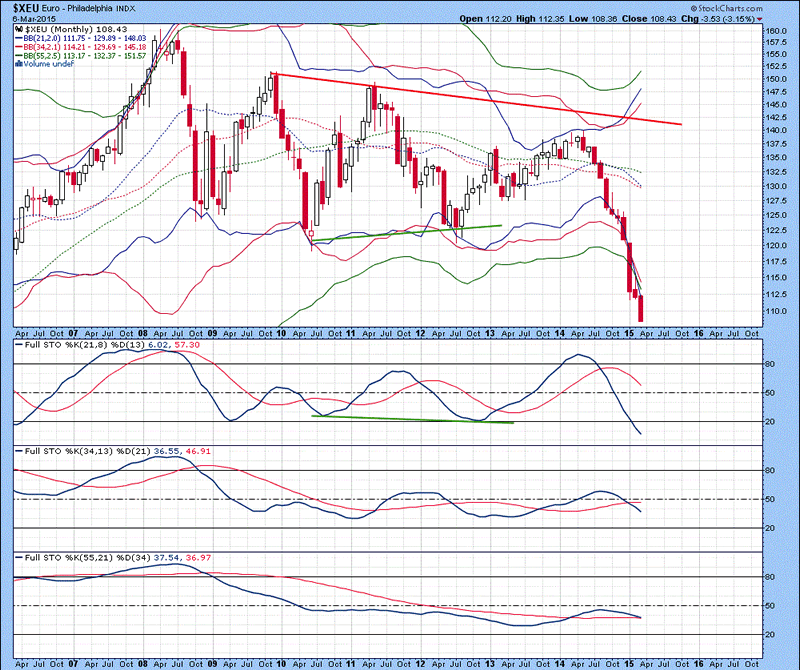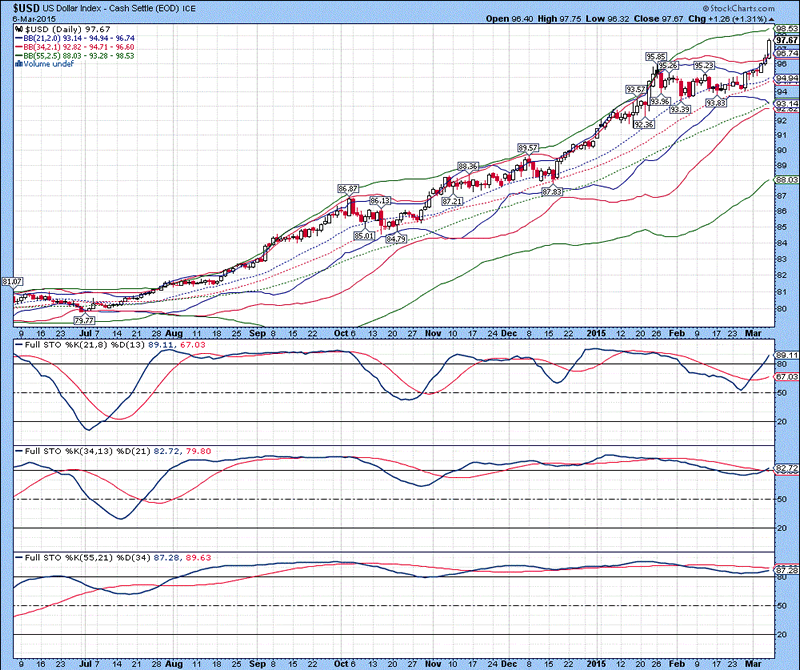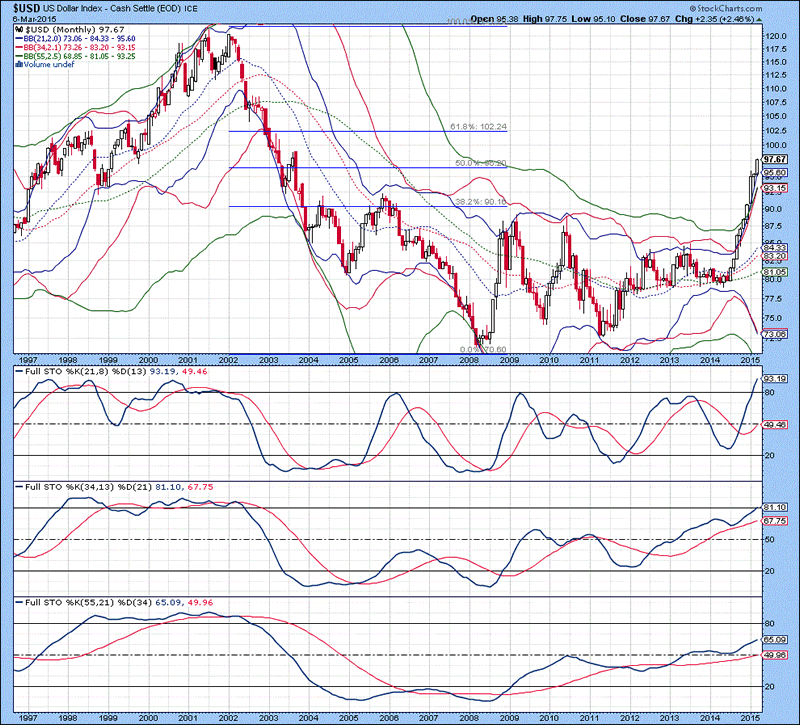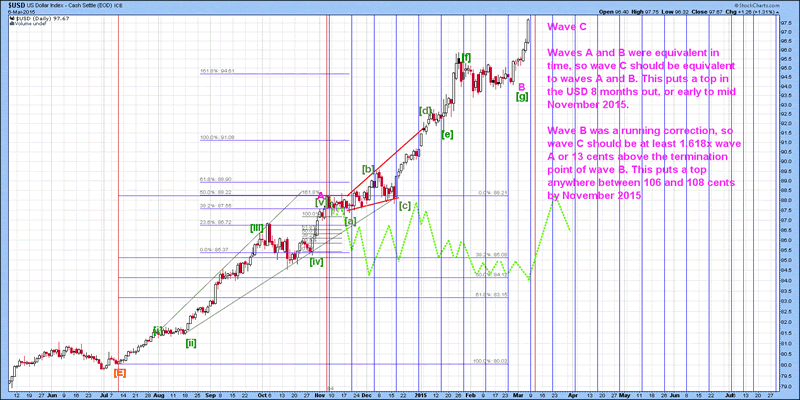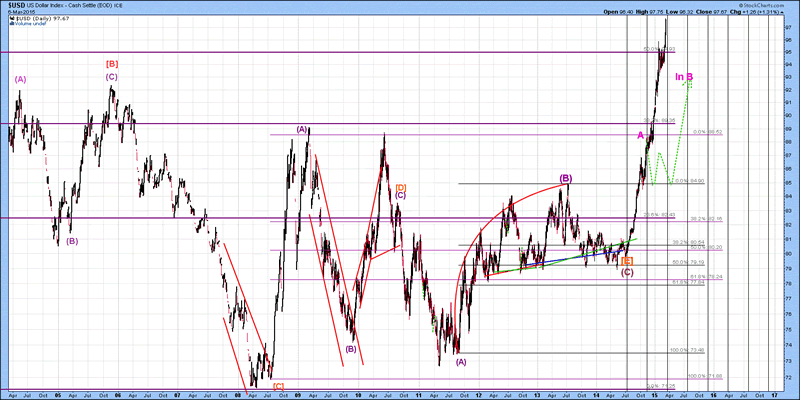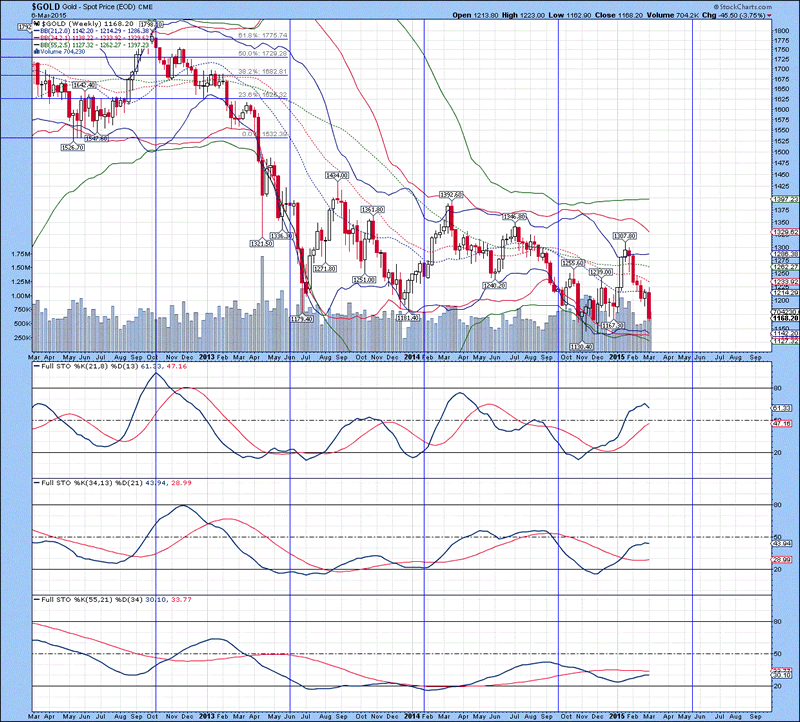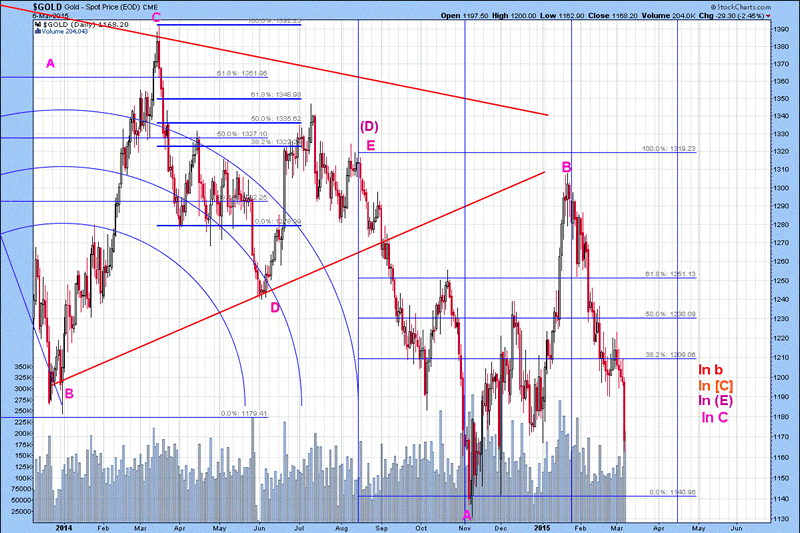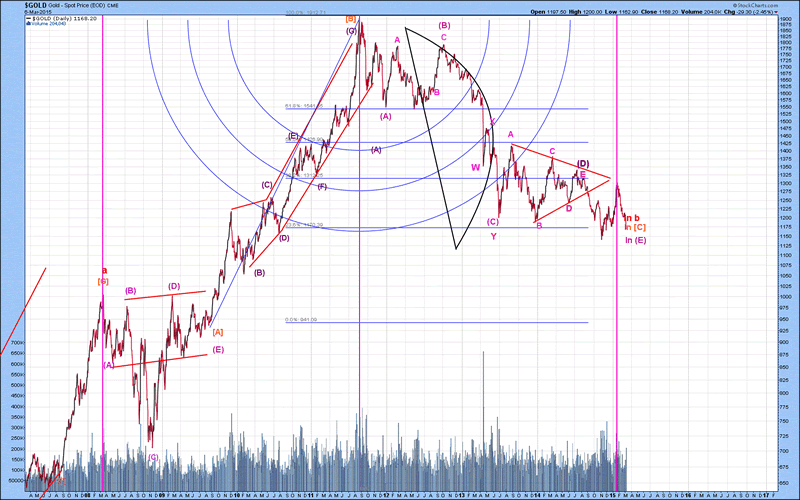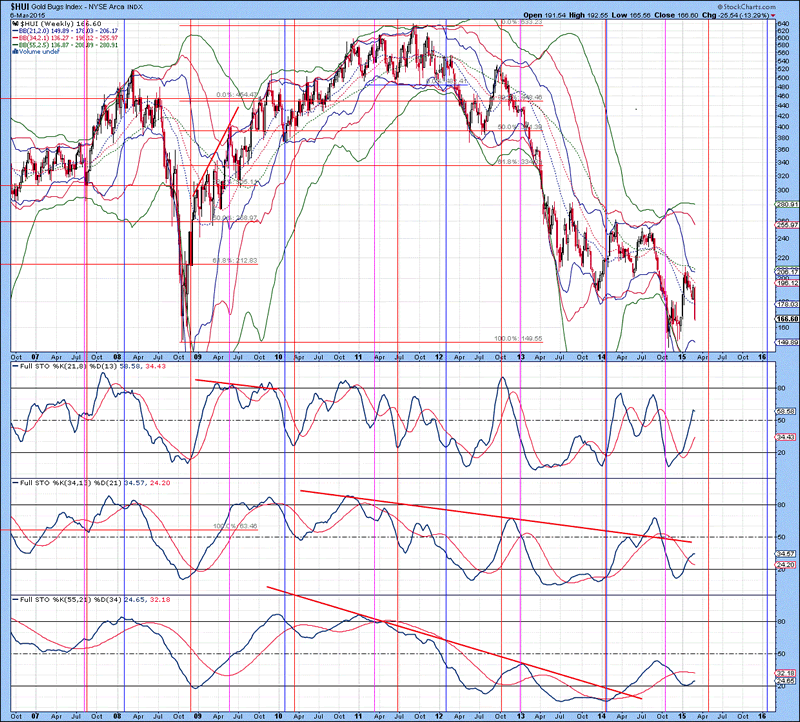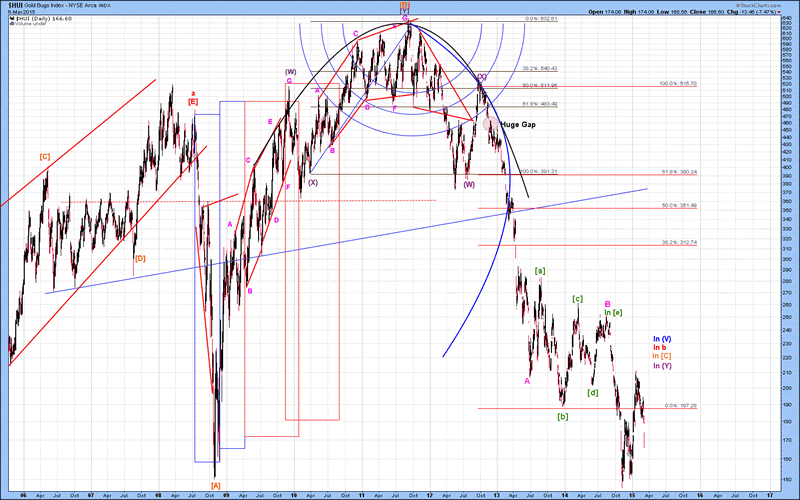by David Petch, Treasure Chests
This article is an update of Gold’s Obituary published back at the end of October 2014. Nothing has changed since that forecast, except the passage of time to arrive at where we are today. Analysis will cover a few currencies and different markets, which should provide a flavour of where things are heading over the next 6-8 months. As a hint, being long commodities as a whole is not recommended in the slightest.

I was going to start things off with the Canadian Dollar which should find support no sooner than 72 cents, but since it is a commodity currency, that should come as no surprise. Rather, I thought it would be more appropriate to cover the currency that stands to lose the most…the Euro. The monthly chart of the Euro is shown below, with the upper 21 MA Bollinger Band® above the 34 MA Bollinger Band indicates a very overbought condition still remains in effect. The lower 21 MA Bollinger Band is beneath the 34 and 55 MA Bollinger Bands to create an oversold condition, but with an overbought condition in the presence of rising upper Bollinger Bands and declining stochastics, the overbought trend remains dominant. All three upper Bollinger Bands are still rising and until at least the 21 and 34 MA Bollinger Bands curl down, there is no indication of a bottom. Full stochastics 1, 2 and 3 are shown below in order of descent, with the %K beneath the %D in all three instances. Extrapolation of the %K trend in stochastic 1 indicates a bottom is not likely to be put in place for at least another 6-8 months. With sideways price action after the 2008 top for 6.5 years and nothing but lower lows and lower highs, the technical setup in September suggested the decline that is underway and what is left to come.
The daily chart of the US Dollar Index is shown below, with lower 21 and 34 MA Bollinger Bands curling down with rising stochastics is a very strong confirmation of higher valuations in the coming weeks. The upper 21 MA Bollinger Band is above the 34 MA Bollinger Band, indicates an overbought condition was generated. This was further confirmed by the huge price excursion above both of these Bollinger Bands on Friday. I am expecting weakness to last for another 1-2 days, followed by an incredibly strong move higher, more of which will be described in this report. Yesterday’s research report indicated the trend for the HUI with specific targets. I have some ideas and will present them tomorrow for what looks like a good trade once the sharp move in the US Dollar pulls back a bit over the next few days. Full stochastics 1, 2 and 3 are shown below in order of descent, with the %K above the %D in 1 and 2 and beneath the %D. Extrapolation of the %K in stochastics 1 and 2 suggest further upside. The US Dollar Index appears overbought, but as longer-term charts will be shown, this is a very natural reaction to a longer-term consolidation.
The monthly chart of the US Dollar Index is shown below, with the upper 21 MA Bollinger Band above the 34 and 55 MA Bollinger Bands indicates a very overbought condition has been generated. Also, price excursions for 4 months have existed above the 55 MA Bollinger Band. Although an extremely overbought condition has been generated that will see a retracement to the lows of the breakout prior to Friday happen early next year, all three lower Bollinger Bands are declining and until the lower 21 and 34 MA Bollinger Bands curl up, there will be no indication of a top being put in place. Full stochastics 1, 2 and 3 are shown below in order of descent, with the %K above the %D in all three instances. There is no indication of a top anytime soon, but the Elliott Wave counts to follow hone in on this thought.
The short-term Elliott Wave count of the US Dollar Index is shown below, with wave C finally underway. The green dashed line is the pattern I “thought” would form once wave A completed. It was very quickly identified that wave B was forming a running correction following a Diametric Triangle pattern (Glenn Neely’s masterful work for identifying new NeoWave patterns). Under the rules described by NeoWave (A much more scientific approach to Elliott Wave analysis), a running correction that occurs in a zigzag pattern should have wave C extended by at least 1.618x of wave A. As per the US Dollar Index under analysis here, wave C should be 13 cents in price, or see a top somewhere between 107 and 108. Waves A and B were very similar in time, so in principle, wave C should be the summation of the total time consumed by waves A and B. Based upon this, the magic time frame of November 2015 is determined. It is very important to understand that a zigzag pattern (5-3-5) is forming for wave (A), which represents the higher order wave count above wave C now forming. Wave C should be impulsive in nature, but if it evolves into a terminal impulse (3-3-3-3-3) with wave 2-4 overlap, then the entire pattern of wave C should be retraced in a period of time shorter than it took to form (If a top is put in place in November 2015, then wave C should be retraced in less than 8 months, or before July 2016). The pattern presented is extremely bullish and should not be overlooked. The US Dollar strength is about to be revealed in the coming months ahead.
The mid-term Elliott Wave count of the US Dollar Index is shown below, with wave C now underway. Again, the green line shows what I thought was going to happen way back in early November. The fact it did not follow it is an indicator of how strong the move up is and will continue to be. There was the potential for a double Head and Shoulders pattern to take the US Dollar Index down to 73.0, but was invalidated when it broke above 81.70. The chart shows nothing but sideways price action with wild swings over a 10 year period, with a subsequent breakout that is showing no sign of rolling over. There is nothing more to really say about the US Dollar except WOW, it’s rise is really going to have a negative impact on commodity prices going forward, which are already depressed.
So if the US Dollar is going to continue its meteoric trend, what is the most likely commodity to take it on the chin? Why simple…that would be Gold. The weekly chart of Gold is shown below, with all three lower Bollinger Bands in close proximity to each other with stochastics hooking down strongly suggests that fresh new lows are on the horizon. Full stochastics 1, 2 and 3 are shown below in order of descent, with the %K above the %D in 1 and 2 and beneath the %D in 3. The %K in stochastics 1 and 2 have hooked down, indicating at least another 4-6 months of weakness in the price of Gold is likely. From a structural perspective, this chart is a mess…there is nothing but a series of lower lows and lower highs. Breaking beneath a 14 month consolidation pattern in September was the Kiss of Death and the decline for the month of March is just a prelude for what lies ahead in the coming months. There will be more money made betting against the price of Gold than trying to go long.
The mid-term Elliott Wave count of Gold is shown below, with wave C.(E).[C] thought to be forming at present. Waves A and B were nearly equivalent in time, so wave C should be equal to the sum of waves A and B. Interestingly, waves A and B consumed 5.25 months so a bottom in Gold should be put in place sometime in late July/early August 2015. I want to stress the US Dollar Index is not expected to top out for 3 months after Gold bottoms, so do not think that the markets of everything are going to top and bottom in a linear fashion. The next Figure provides a longer-term perspective of the Elliott Wave count, with the anticipated bottom.
The long-term Elliott Wave count of Gold is shown below, with wave [C] still thought to be forming. It is important to note that the entire corrective pattern from 2008 until present is thought to be a part of the same corrective structure, Given the long periods of time taken for waves [B] and [C] to form, Waves [D] up and [E] down yet to form should take anywhere from 2-4 years each. With wave [C] expected to bottom around late July 2015, wave [D] up, should see a very sharp move to the upside, that really happens once the US Dollar Index tops out around in early November 2015. The bottom for wave [C] is expected to be the start point of wave [B], or anywhere between $940-944/ounce. Based upon the pattern in the price of Gold, wave b should not complete until at least 2019 and maximally at 2023. I am not able to resolve this time frame, because the amount of time waves [D] and [E] take remain elusive. This suggests very strong deflation between now and then, followed by a sharp rise only when the absolute bottom is in and then people panic. Gold is falling alongside many currencies, so anyone buying Gold in Canadian or Australian Dollars may find the price similar now as 4-6 months from now. The real problem is owning Gold with a US Dollars, as the price of Gold is simply not going to hold value. The time will come to go long, but being short makes more sense at the moment.
Now that Gold has been discussed, what about their related stocks? The weekly chart of the HUI is shown below, with the lower 34 MA Bollinger Band marginally beneath the 55 MA Bollinger Band, indicates an oversold condition has been generated. Full stochastics 1, 2 and 3 are shown below in order of descent, with the %K above the %D in 1 and 2 and beneath the %D in 3. There are micro-inflections of the %K curling down in all three instances and when that happens on this chart, the top has been put in place. The downtrend line in stochastic 2 remains intact, so a failure at this point would further add weakness to HUI. WHEN (not if) a weekly close below 149 in the HUI occurs, there is no immediate support until the 100 area. Based upon the expected slam for Gold, the HUI is likely to not find support until the 88-92 area is reached (a parallel target for the Euro).
The long-term Elliott Wave count of the HUI is shown below, with wave C.(Y) still thought to be forming. Gold is expected to bottom well before the HUI. Gold stocks valuations depend upon the price of Gold and function as a barometer of the overall stock markets. The broad stock market indices of the US are expected to top out at some point in August and decline into the June-August 2016 time frame as per the Contracting Fibonacci Spiral as a function of its Chiral Inversion in May 2013. So…I find it hard to see the HUI going anywhere until around February 2016…this time frame was arrived at wave C being equivalent in time to waves A and B. Does this happen, who knows, but one thing is certain…Gold is not set to bottom until the latter part of July 2015 so Gold stocks should remain weak throughout this period of time.
That is all for today…I will list recommendations on how to play this tomorrow AM.



